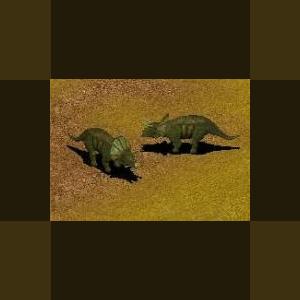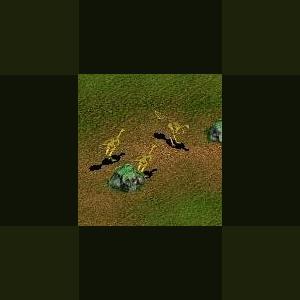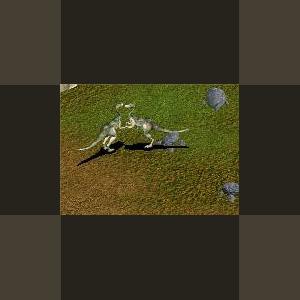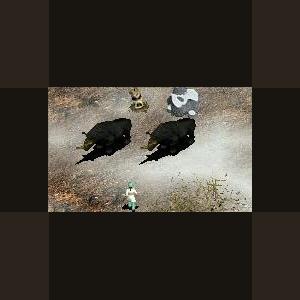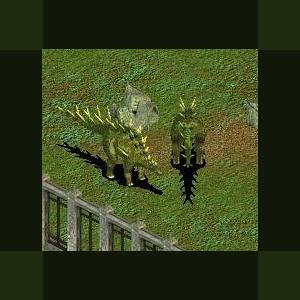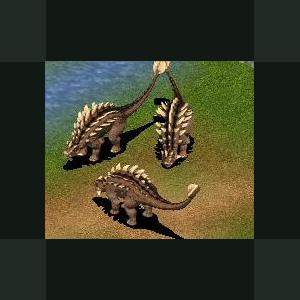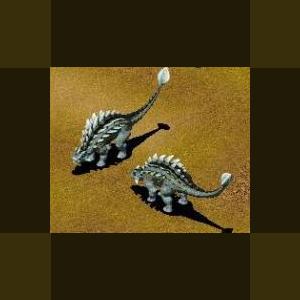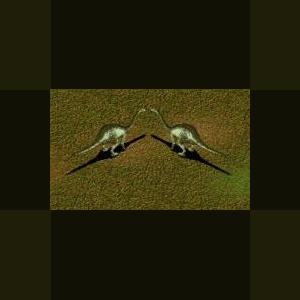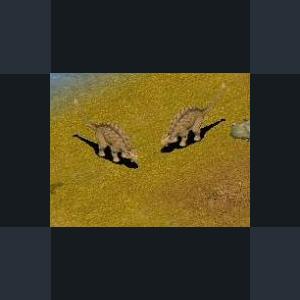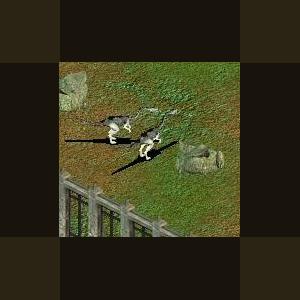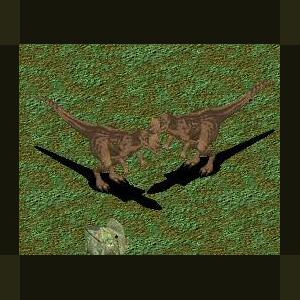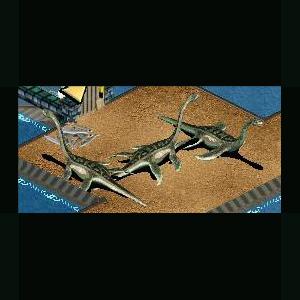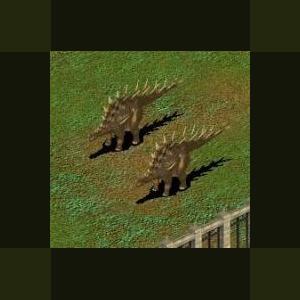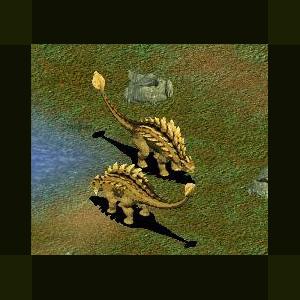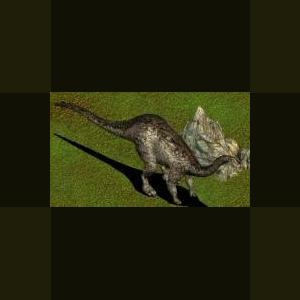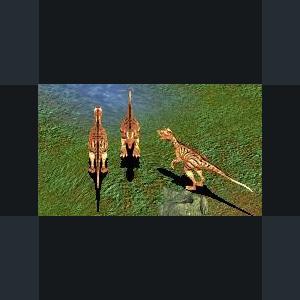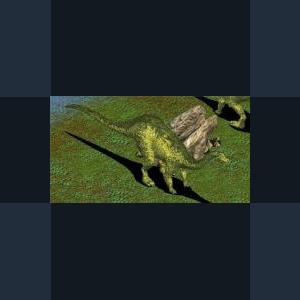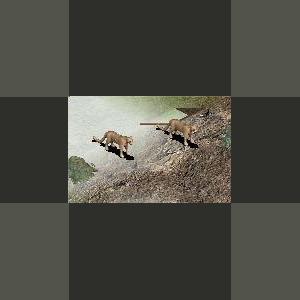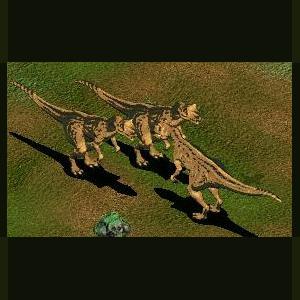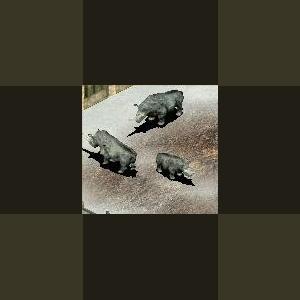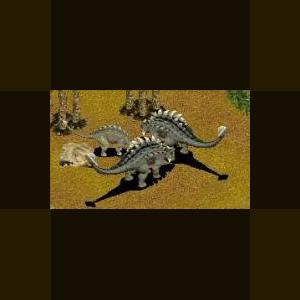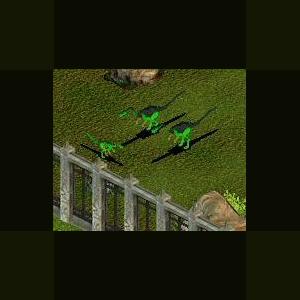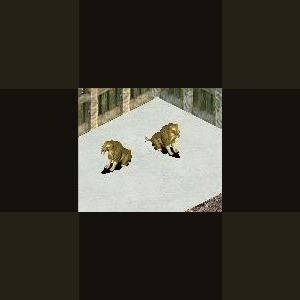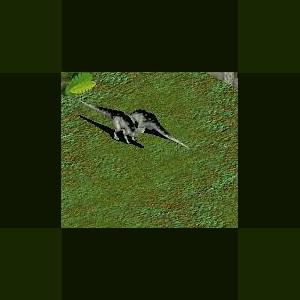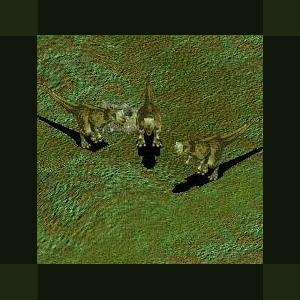Dinosaurs
Creatures from another age
241 files
-
Diceratus by Moondawg
By Guest
Diceratus (meaning "two-horned") is a ceratopsid herbivorous dinosaur genus from the Late Cretaceous period of North America. It is known only from a single poorly preserved skull discovered in Wyoming and described in 1905 as Diceratops.
For many years, it had been considered a species within the genus Triceratops, but recent analysis (Forster, 1996) suggests it is a distinct genus. Since the Diceratops name was preoccupied, it was renamed to Diceratus in 2008.
Diceratus was first described as Diceratops ("two horned face"), but it was found that the name was already in use for a hymenopteran (Foerster, 1868). It was given its current name by Octávio Mateus in 2008.
The paper that described Diceratus was originally part of O. C. Marsh's magnum opus, his Ceratopsidae monograph. Unfortunately, Marsh died (1899) before the work was completed, and John Bell Hatcher endeavored to complete the Triceratops section. However, he died of typhus in 1904 at the age of 42, leaving the paper still uncompleted. It fell to Richard Swann Lull to complete the monograph in 1905, publishing Hatcher's description of a skull separately and giving it the name Diceratops hatcheri.
Since the Diceratops paper had been written by Hatcher, and Lull had only contributed the name and published the paper after Hatcher's death, Lull was not quite as convinced of the distinctiveness of Diceratops, thinking it primarily pathological. By 1933, Lull had had second thoughts about Diceratops being a distinct genus and he put it in a subgenus of Triceratops: Triceratops (Diceratops), including T. obtusus; largely attributing its differences to being that of an aged individual.
200 downloads
0 comments
Updated
-
Citipati by Moondawg
By Guest
Citipati (Sanskrit for 'funeral pyre lord') is a genus of oviraptorid theropod dinosaur from the Late Cretaceous Period of what is now Mongolia.
It is one of the best-known oviraptorids, thanks to a number of well-preserved skeletons, including several specimens found in brooding positions atop nests of eggs. These nesting specimens have helped to solidify the link between non-avian dinosaurs and birds.
The type species, Citipati osmolskae, was described by James M. Clark, Mark Norell, and Rinchen Barsbold in 2001. A second, as yet unnamed species may also exist. Citipati is often confused with the similar Oviraptor.
The largest Citipati were emu-sized animals and, at about 3 meters (9 ft) long, were the largest oviraptorids until Gigantoraptor was described in 2007. Like other oviraptorids, Citipati had an unusually long neck and shortened tail, compared to most other theropods. Its skull was unusually short and highly pneumatized (riddled with openings in the bone structure), ending in a stout, toothless beak. Perhaps the most distinctive feature of Citipati was its tall crest, superficially similar to that of a modern cassowary. The crest was relatively low in the type species, C. osmolskae, and taller, with a pointed tip, in a referred specimen which has not yet been assigned a specific name (provisionally labelled C. sp.).
172 downloads
0 comments
Updated
-
Harpymimus by Moondawg
By Guest
Harpymimus was a basal ornithomimosaur from the Early Cretaceous Period of what is now Mongolia. Unlike later, more derived ornithomimosaurs,
The holotype specimen (IGM 100/29, Mongolian Academy of Sciences, Ulan Bator, Mongolia) consists of an almost complete skeleton, lacking portions of the pectoral girdle, pelvic girles, and hindlimbs. It was recovered at Dundgovi Aimag (Eastern Gobi Province), from an exposure of the Shinekhudug Formation (Shinekhudukskaya Svita; Hauterivian to Barremian). The etymology of Harpymimus involves a reference to the fearsome Harpy of Greek mythology (Greek harpyiai = "Harpies" + Greek mimos = "mimic"). Only a single species is known for this genus, H. oklandnikovi. Other dinosaurs collected from the Shinekhudug Formation at Dundgov include the ceratopsian Psittacosaurus mongoliensis and the ornithopod Altirhinus kurzanovi.
Inspired by the Zoo Tek Brains Trust
134 downloads
0 comments
Updated
-
Elasmotherium Sibiricum by Moondawg
By Guest
I remade this animal for Pukkie ... I also remade this animal for those Tekkies who would prefer the Black version to the Grey...
There is nearby a wide steppe, and there dwells, it is told, an animal smaller than a camel, but taller than a bull. Its head is the head of a ram, and its tail is a bull’s tail. Its body is that of a mule and its hooves are like those of a bull. In the middle of its head it has a horn, thick and round, and as the horn goes higher, it narrows (to an end), until it is like a spearhead. Some of these horns grow to three or five ells, depending on the size of the animal. It thrives on the leaves of trees, which are excellent greenery. Whenever it sees a rider, it approaches and if the rider has a fast horse, the horse tries to escape by running fast, and if the beast overtakes them, it picks the rider out of the saddle with its horn, and tosses him in the air, and meets him with the point of the horn, and continues doing so until the rider dies. But it will not harm or hurt the horse in any way or manner.
289 downloads
0 comments
Updated
-
Chialingosaurus by Moondawg
By Guest
Chialingosaurus (meaning "Chialing Lizard") was a type of stegosaur similar to Kentrosaurus from the Upper Shaximiao Formation, Late Jurassic beds in Sichuan Province in China.
Its age makes it one of the oldest species of stegosaurs, living about 160 million years ago. Since it was an herbivore, scientists think that Chialingosaurus probably ate ferns and cycads, which were plentiful during the period when Chialingosaurus was alive. Its name is taken from the Chialing River in southern China. Perhaps growing up to 13 ft (4m) long and weighing just 330 pounds (150 Kg), much less than other later stegosaurs.
Collected by the geologist Kuan in 1957 in Quxian County, the dinosaur was named by paleontologist C. C. Young two years later, although only very incomplete fossilized remains of Chialingosaurus have been found, and those fossil remains belong to a juvenile. In 1969, Rodney Steel suggested that Chialingosaurus might have actually been an early ancestor of other stegosaurs, but it is difficult to tell: the type specimen, Chialingosaurus kuani is known from only one partial skeleton, the original material having been supplemented in 1978 by Zhou of the Municipal Museum of Chongqing.
235 downloads
0 comments
Updated
-
Panoplosaurus by Moondawg
By Guest
Pantosaurus is an extinct genus of plesiosaur from the Late Jurassic (Oxfordian) of what is now Wyoming. It lived in what used to be the Sundance Sea.
The species Muraenosaurus reedii is in fact a junior synonym of Pantosaurus
Pantosaurus possesses between 35 and 40 cervical vertebrae, which are very similar in proportion and morphology to those of Muraenosaurus leedsii from the Oxford Clay Formation (Callovian, Middle Jurassic) of England. The forelimb of Pantosaurus however can be differentiated from that of Muraenosaurus, such as the relatively large size of the radius and the corresponding humerus-radius articulation. No Pantosaurus cranial material has yet been discovered.
161 downloads
0 comments
Updated
-
Pinacosaurus by Moondawg
By Guest
Pinacosaurus ("plank lizard") is a genus of medium-sized ankylosaur dinosaurs that lived from the late Santonian to the late Campanian stages of the late Cretaceous period.
Pinacosaurus was a lightly-built, medium-sized ankylosaur with a long skull that reached a length of 5 meters (16 ft) Like all ankylosaurids, it had a bony club at the end of its tail which it used as a defensive weapon against predators such as Tarbosaurus. The most unusual element in the original specimen is the presence of two additional egg-shaped holes, one on top of the other, where the nostrils are normally found. The openings are characteristic of the genus, and the number varies: Godefroit et al. described four in 1999, and in 2003 a juvenile specimen with of five pairs of openings was described.
* Inspired by the Zoo Tek Brains Trust
158 downloads
0 comments
Updated
-
Brachytrachelopan by Moondawg
By Guest
Brachytrachelopan is an unusual short-necked sauropod dinosaur from the latest Jurassic Period (Tithonian) of Argentina.
The holotype and only known specimen (Museo Paleontológico Egidio Feruglio) was collected from an erosional exposure of fluvial sandstone within the Cañadón Cálcero Formation on a hill approximately 25 km north-northeast of Cerro Cóndor, Chubut Province, in west-central Argentina, South America. Though very incomplete, the skeletal elements recovered were found in articulation and include eight cervical, twelve dorsal, and three sacral vertebrae, as well as proximal portions of the posterior cervical ribs and all the doral ribs, the distal end of the left femur, the proximal end of the left tibia, and the right ilium. Much of the specimen was probably lost to erosion many years before its discovery. The type species was named in honor of Daniel Mesa, a local shepherd who discovered the specimen while searching for lost sheep. The genus name translates as "short-necked Pan", Pan being the god of the shepherds.
194 downloads
0 comments
Updated
-
Silvisaurus by Moondawg
By Guest
Silvisaurus, from the Latin silva "wood" and Greek saurus "lizard", is a nodosaurid ankylosaur from the middle Cretaceous of Kansas.
The holotype was recovered by T. H. Eaton from the University of Kansas from exposures of the Dakota Formation (late Aptian-early Cenomanian) in Kansas, and consists of an incomplete skeleton with skull and sacrum. To date, Silvisaurus includes only the type species, S. condrayi.
Based on these remains, the animal is estimated to have been approximately four meters in length (13 ft). Its skull measures 33 centimeters in length (13 in) and is 25 centimeters wide (10 in). The osseous secondary palate is poorly developed in Silvisaurus, the dentary includes at least twenty-five teeth, the basal tubera of the basiocciptial are bulbous, and each premaxilla holds eight to nine teeth. Besides the usual rounded and polygonal osteoderms, Silvisaurus may have also sported bony spines on its shoulders and tail.
This taxon represents a relatively primitive nodosaurid, and Vickaryous et al. (2004) have stated that "Sauropelta edwardsorum, Silvisaurus condrayi, and Pawpawsaurus campbelli form a basal polytomy nested deep to Cedarpelta."
142 downloads
0 comments
Updated
-
Valdosaurus by Moondawg
By Guest
Valdosaurus ("Weald Lizard") was a small, bipedal herbivorous ornithopod dinosaur found on the Isle of Wight, elsewhere in Europe, and Africa.
It lived during the Early Cretaceous.
The type species, V. canaliculatus, was described in 1975 by Peter Galton. A second species, V. nigeriensis is known from Niger, but is based on partial fossils. Valdosaurus is an iguanodont.
118 downloads
0 comments
Updated
-
Yangchuanosaurus by Moondawg
By Guest
Yangchuanosaurus was a theropod dinosaur that lived in China during the Late Jurassic period, and was similar in size and appearance to its North American contemporary, Allosaurus.
It hails from the Upper Shaximiao Formation and was the largest predator in a landscape which included the sauropods Mamenchisaurus and Omeisaurus as well as the Stegosaurs Chialingosaurus, Tuojiangosaurus and Chungkingosaurus
In 1976, an almost complete skeleton of what was to be named Yangchuanosaurus shangyouensis was uncovered by a construction worker during the construction of the Shangyou Reservoir Dam in Yangshuan County in Sichuan Province. Since then further skeletons have been recovered.
Yangchuanosaurus shangyouensis reached about 7 metres long (23 ft) and had a skull around 80 cm long (32 in). Its relative Y. magnus grew larger still; up to 10 metres long (33 ft), with a skull up to 1 metre (3 ft) in length. There was a bony knob on its nose and multiple hornlets and ridges, similar to Ceratosaurus. It had a massive tail that was about half its length.
The original skeleton of Yangchuanosaurus shangyouensis is on display at the Municipal Museum of Chongqing, as is some material of Y. magnus. Another, recovered from Xuanhan County in Sichuan, is on display in the Beijing Museum of Natural History.
181 downloads
0 comments
Updated
-
Pantosaurus by Moondawg
By Guest
Pantosaurus is an extinct genus of plesiosaur from the Late Jurassic (Oxfordian) of what is now Wyoming. It lived in what used to be the Sundance Sea.
The species Muraenosaurus reedii is in fact a junior synonym of Pantosaurus
Pantosaurus possesses between 35 and 40 cervical vertebrae, which are very similar in proportion and morphology to those of Muraenosaurus leedsii from the Oxford Clay Formation (Callovian, Middle Jurassic) of England. The forelimb of Pantosaurus however can be differentiated from that of Muraenosaurus, such as the relatively large size of the radius and the corresponding humerus-radius articulation. No Pantosaurus cranial material has yet been discovered.
193 downloads
0 comments
Updated
-
Chungkingosaurus by Moondawg
By Guest
Chungkingosaurus, meaning "Chongqing Lizard", was a genus of dinosaur from the Late Jurassic from the Upper Shaximiao Formation in what is now China. It is classified as a Stegosaurid.
The type species, Chungkingosaurus jiangbeiensis, was found near Chongqing, China. in 1977 and described by Dong Zhiming, Zhou Shiwu, and Chang Yihong in 1983. There were many stegosaurs found in China in 1977 (the year Chungkingosaurus was found), but Chungkingosaurus was the smallest of these.
One of the smallest of the family at 3-4 metres long (10-13 ft), Chungkingosaurus had at least five spikes on its thagomizer. It had a rather high and narrow skull and large, thick bony plates. Like all stegosaurs, it was a herbivore. Chungkingosaurus had spiny plates on its back, which were arranged in pairs, but the total number is unknown. A specimen in the Chongqing Municipal museum is represented as having 14 pairs of plates. This specimen also had two pairs of tail spikes.
Chungkingosaurus is thought to have coexisted with large plant-eaters and stegosaurids such as Chialingosaurus, Tuojiangosaurus, Mamenchisaurus, and Omeisaurus. It may have also faced being a meal of predators such as the theropods Yangchuanosaurus and Szechuanosaurus.
200 downloads
0 comments
Updated
-
Struthiosaurus by Moondawg
By Guest
Struthiosaurus (Latin struthio = ostrich + Greek sauros = lizard) is one of the smallest known and most primitive nodosaurid dinosaurs, From the Late Cretaceous period (Campanian-Maastrichtian) of Austria and Romania in Europe.
Originally described in 1871, many species have been referred to Struthiosaurus, most based on very fragmentary and nondiagnostic material.
Three valid species are currently recognized by paleontologists: S. austriacus Bunzel, 1871; S. transylvanicus Nopcsa, 1915; and S. languedocensis Garcia and Pereda-Suberbiola, 2003. Along with Hungarosaurus Osi, 2005, Struthiosaurus is currently one of only two valid members of the Ankylosauria known from Europe. A number of invalid taxa have been shown to be junior synonyms of Struthiosaurus, including: Crataeomus Seeley, 1881; Danubiosaurus Bunzel, 1871; Pleuropeltis Seeley, 1881; and Lepisanosaurus Nopcsa, 1918. Another European ankylosaurid, Rhodanosaurus Nopsca, 1929, from Campanian-Maastrichtian-age rocks of southern France, is now regarded as a nomen dubium and referred to Nodosauridae incertae sedis.
The three valid species of Struthiosaurus differ from one another in that S. austricus is smaller than S. transylvanicus and possesses less elongate cervical vertebrae. Also, though the quadrate-paroccipital process contact is fused in S. transylvanicus, it is unfused in S. austricus. The skull of S. languedocensis is presently unknown, but the taxon differs from S. transylvanicus in the shape of the dorsal vertebrae. It differs from S. austricus in the shape of the ischium. (Vickaryous, Maryanska, and Weishampel 2004)
Some workers (Vickaryous, Maryanska, and Weishampel 2004) consider the assignment of Struthiosaurus to the Nodosauridae to be provisional, pending further study and future discoveries
Cladistic analysis of Struthiosaurus (Osi, 2004) indicates that the taxon is a basal member of the Nodosauridae and suggests it may be one of the most basal ankylosaurs in the clade Ankylosauria.
181 downloads
0 comments
Updated
-
Camarasaurus by Moondawg
By Guest
Camarasaurus (KAM-ah-rah-SAWR-us) meaning 'chambered lizard', referring to the holes in its vertebrae was a genus of quadrupedal, herbivorous din
The arched skull of Camarasaurus may have contributed to the name 'chambered lizard'. The skull was remarkably square and the blunt snout had many fenestrae, though it was sturdy and is frequently recovered in good condition by paleontologists.
The 19 centimeter long (7.5 in) teeth were shaped like chisels (spatulate) and arranged evenly along the jaw. The strength of the teeth indicates that Camarasaurus probably ate coarser plant material than the slender-toothed diplodocids. Like a chicken, it may have swallowed stones (gastroliths) to help grind the food in the stomach and then regurgitated or passed them when they became too smooth.
Inspired by the Zoo Tek Brains Trust
267 downloads
0 comments
Updated
-
Proceratosaurus by Moondawg
By Guest
Proceratosaurus is a genus of medium-sized carnivorous theropod dinosaur from the Middle Jurassic of England.
Originally thought to be an ancestor of Ceratosaurus due to the similar small crest on its snout, it is now considered a coelurosaur, one of the earliest known. Proceratosaurus may have been related to the ancestors of later forms such as Ornitholestes and the tyrannosaurs.
207 downloads
0 comments
Updated
-
Alamosaurus by Moondawg
By Guest
Alamosaurus, ("meaning "Alamo lizard"), is a genus of titanosaurian sauropod dinosaur from the Late Cretaceous Period of what is now North America.
Contrary to popular assertions, this dinosaur is not named after the Alamo in San Antonio, Texas, or the battle that was fought there. The holotype, or original specimen, was discovered in New Mexico and, at the time of its naming, Alamosaurus had not yet been found in Texas. Instead, the name Alamosaurus comes from Ojo Alamo, the former name for the geologic formation in which it was found (that part of the Ojo Alamo Formation has since been reassigned to Kirtland Shale) and which was, in turn, named after the nearby Ojo Alamo trading post. The term alamo itself is a Spanish word meaning "poplar" and is used for the local subspecies of cottonwood tree. The term saurus is derived from saura , Greek for "lizard" and is the most common suffix used in dinosaur names. There is one species (A. sanjuanensis), which is named after San Juan County, New Mexico, where the first remains were found. Both genus and species were named by Smithsonian paleontologist Charles W. Gilmore in 1922.
Alamosaurus is undoubtedly a derived member of Titanosauria, but relationships within that group are far from certain. One major analysis unites Alamosaurus with Opisthocoelicaudia in a subfamily Opisthocoelicaudinae of the family Saltasauridae (Wilson, 2002). A major competing analysis finds Alamosaurus as a sister taxon to Pellegrinisaurus, with both genera located just outside Saltasauridae (Upchurch et al., 2004). Other scientists have also noted particular similarities with the saltasaurid Neuquensaurus and the BrazilianTrigonosaurus (the "Peiropolis titanosaur") which is used in many cladistic and morphologic analyses of titanosaurians (Lehman and Coulson, 2002).
377 downloads
0 comments
Updated
-
American Lion by Moondawg
By Guest
The American lion (Panthera leo atrox) also known as the North American or American cave lion, is an extinct feline known from fossils.
It was one of the largest subspecies of lion to have ever existed, comparable in size to the Early Middle Pleistocene primitive
cave lion Panthera leo fossilis and was about 25% larger than the modern African lion.
The American lion is an extinct animal which originated in North America and went on to
colonize part of South America as part of the Great American Interchange. The body length
of the American lion is estimated to have been 1.6-2.5 m (5.25-8.20 feet). Thus it was
comparable in size to its close relative, the extinct lion, Panthera leo fossilis, or the
modern species of Siberian tiger, but still smaller than their contemporary competitor for
prey, the Giant short-faced bear, which was the largest carnivoran of their era.
Approximately one hundred specimens of American lions have been recovered from the La Brea
Tar Pits, in Los Angeles, so their body structure is well known. The features and teeth of
the extinct American lion strongly resemble modern lions, but they were considerably larger.
South of Alaska, the American lion first appeared during the Sangamonian (the last
interglacial). After that it was widespread in the Americas from Alaska to Peru, although
it was absent from eastern North America and peninsular Florida. As did many other large
mammals, it went extinct at the end of the Pleistocene, about 10,000 years ago. By then
the American lion was one of the abundant Pleistocene megafauna, a wide variety of very
large mammals who lived during the Pleistocene. Remains are most common in the Yukon and
from the La Brea Tar Pits.
531 downloads
0 comments
Updated
-
Megalosaurus by Moondawg
By Guest
Megalosaurus (meaning "Great Lizard", from Greek,megalo- meaning 'big', 'tall' or 'great' and sauros meaning 'lizard') is a genus of large meat-eating theropod dinosaurs of the Middle Jurassic Period (Bathonian) o
Megalosaurus was the first dinosaur to be described. Part of a bone was recovered from a limestone quarry at Cornwell near Chipping Norton, Oxfordshire, England in 1676. The fragment was sent to Robert Plot, Professor of Chemistry at the University of Oxford and first curator of the Ashmolean Museum, who published a description in his Natural History of Oxfordshire in 1677. He correctly identified the bone as the lower extremity of the femur of a large animal and he recognized that it was too large to belong to any known species; he considered it to be the thigh bone of a giant. The bone has since been lost but the illustration is detailed enough to identify it clearly as the femur of a Megalosaurus.
The Cornwell bone was described again by Richard Brookes in 1763. He named it Scrotum humanum, while describing its similar appearance to a pair of human testicles. The label was not considered to be a "name" for the animal in question at the time, and was not used in subsequent literature. Technically, the name was published after the advent of binomial nomenclature, and although this name theoretically had priority over Megalosaurus, the rules of the ICZN state that if a name falls into disuse for 50 years after publication, it is no longer in competition for priority. Therefore, the name Scrotum humanum is a nomen oblitum, or "forgotten name".
More discoveries were made, starting in 1815, again at the Stonesfield quarry. They were acquired by William Buckland, Professor of Geology at the University of Oxford and dean of Christ Church. He did not know to what animal the bones belonged but, in 1818, after the Napoleonic Wars, the French comparative anatomist Georges Cuvier visited Buckland in Oxford and realised that the bones belonged to a giant lizard-like creature. Buckland then published descriptions of the bones in Transactions of the Geological Society, in 1824 (Physician James Parkinson had described them in an article in 1822).
226 downloads
0 comments
Updated
-
Elasmotherium by Moondawg
By Guest
Elasmotherium ("Thin-Plate Beast") was a genus of giant rhinoceri which stood, on average, two meters (7 feet) high and six meters (20 feet) long, with a single two-meter-long horn in the forehead.
The genus appeared during the Late Pliocene in Central Asia, being derived from the genus Sinotherium. E. inexpectatum and E. peii inhabited Eastern China during the Upper Pliocene to Early Pleistocene. They disappeared approximately 1.6 Ma. The earliest records of Elasmotherium species in Russia are known from the Upper Pliocene assemblages near the Black Sea. E. caucasicum was widely distributed in this area between 1.1 Ma and 0.8 Ma. The more advanced (and largest member of the genus) E. sibiricum appeared in the Middle Pleistocene. It occupied all of the southwestern part of Russia, reaching eastward to western Siberia, then south into Ukraine and Moldova. Elasmotherians persisted in eastern Europe until the end of the Middle Pleistocene.
Made by request for Pukkie
375 downloads
0 comments
Updated
-
Shamosaurus by Moondawg
By Guest
Shamosaurus is the name given to a genus of dinosaur from the Early Cretaceous. It was an ankylosaurid dinosaur from Mongolia.
Shamosaurus scutatus shares many cranial similarities with Gobisaurus domoculus, including a rounded squamosal, large elliptical orbital fenestrae and external nares, a deltoid dorsal profile with a narrow rostrum, quadratojugal protuberances, and caudolaterally directed paroccipital processes. But the two taxa may be distinguished by differences in the length of the maxillary tooth row, an unfused basipterygoid-pterygoid process in Gobisaurus, the presence on an elongate vomerine premaxillary process in Gobisaurus, and the presence of cranial sculpting in Shamosaurus, but not in Gobisaurus
140 downloads
0 comments
Updated
-
Zephyrosaurus by Moondawg
By Guest
Zephyrosaurus (meaning "westward wind lizard") was a genus of hypsilophodont ornithopod dinosaur.
It is based on a partial skull and postcranial fragments discovered in the Aptian-Albian-age Lower Cretaceous Cloverly Formation of Carbon County, Montana. New remains are under description, and tracks from Maryland and Virginia have been attributed to something like it.
Zephyrosaurus is still very incompletely known. Among other distinctive characteristics, it had a steep face, a raised knob on the upper jaw, and a larger knob on the cheekbone. Some of the bones may have allowed movement within the skull (cranial kinesis) as well. Like other hypsilophodonts, it had beak teeth.
Hans-Dieter Sues named his new genus in recognition of the fossil being found in western North America, and C. R. Schaff, who found the specimen. MCZ 4392, the type specimen, is composed of jaw fragments, the braincase and associated bones, several partial vertebrae, and rib fragments. He found the new genus to represent a previously unknown lineage of hypsilophodont, similar in some respects to Hypsilophodon.
Because of the fragmentary nature of the type, and lack of additional remains, Zephyrosaurus had not attracted much attention until recently, when two separate events brought it more recognition. First, Martha Kutter, in a 2003 abstract, reported on new remains of this genus under study at the Sam Noble Oklahoma Museum of Natural History, including the remains of at least seven individuals with bones from all regions of the body.
Then, Stanford et al. (2004) published on dinosaur tracks from the Patuxent Formation of Maryland and Virginia, which they named Hypsiloichnus marylandicus and attributed to an animal akin to Zephyrosaurus based on the proportions of the hands and feet.
195 downloads
0 comments
Updated
-
Dinictus by Moondawg
By Guest
Dinictis was a member of the Nimravid family, also known as "false saber-toothed cats". It had a sleek body (1.1 m. long), short legs (0.6 m. high) with only incompletely retractable claws, powerful jaws, and a long tail.
It was very similar to its close relative, Hoplophoneus. The shape of its skull is reminiscent of a felid skull rather than of the extremely short skull of the Machairodontinae. Compared with those of the more recent machairodonts, its upper canines were relatively small, but they nevertheless distinctly protruded from its mouth. Below the tips of the canines its lower jaw spread out in the form of a lobe.
Dinictis walked plantigrade (flat-footed), unlike modern felids. It looked like a small leopard and evidently its mode of life was similar to that of a leopard. It was probably not so particular about its food as its descendants, since reduction of the teeth was still in the early stages and Dinictis had not forgotten how to chew. Despite this, in its own environment it would have been a powerful predator.
It lived in the plains of North America around 40 million years ago in the late Eocene and early Oligocene. Fossils were found in Saskatchewan in Canada, and Colorado, Montana, Nebraska, South Dakota, North Dakota, Wyoming, and Oregon in the United States. Dinictis likely evolved from an early Miacis-like ancestor which lived in the Paleocene.
Made by request for Pukkie
253 downloads
0 comments
Updated
-
Aralosaurus by Moondawg
By Guest
Aralosaurus (ar-ahl-o-SORE-us) meaning "Aral Sea lizard", because it was found in the Aral Sea when it began to shrink noticeably.Aralosaurus was a genus of hadrosaurid dinosaur which lived during the Late Cretaceous of what is now Kazakhstan.
Aralosaurus was characterized by a small, bony peak on its nose, much like its relatives Maiasaura and Gryposaurus. Some paleontologists have posited that Aralosaurus was actually a lambeosaurine.
Aralosaurus was a herbivore that lived in the late Cretaceous period, around 95 to 80 million years ago, and was capable of both bipedal and quadrupedal movement. Egg clusters show that Aralosaurus lived in herds and had locations for laying eggs where they would be safe.Several relatives, such as Jaxartosaurus have also been found in the surrounding area where Aralosaurus was found.
Aralosaurus was about the size of an elephant, being up to 9 m long, but was over 5,000 kilograms in weight. Although very little is known about Aralosaurus (only one near complete skull has been found); it was identified by a beak with nearly 1,000 small teeth in 30 rows. These teeth were used for breaking up plant matter by chewing, a feature common in herbivorous dinosaurs, but unusual for reptiles.The back of an Aralosaurus skull was wide, a feature suggestive of large jaw muscles used to power its chewing apparatus
334 downloads
0 comments
Updated
-
Fukuiraptor by Moondawg
By Guest
now Japan.
Scientists first thought it was a member of the Dromaeosauridae, but after studying the fossils they now believe it was related to Allosaurus. The type specimen is the skeleton of an individual about 4.2 metres long. It is thought that this specimen was not mature and an adult may have been larger. However, the other individuals recovered from the same locality are all juveniles that were smaller than the holotype (Currie & Azuma, 2006), in the smallest case less than a quarter of the holotype's size.
This specimen caused some confusion upon its initial discovery because its hand claw was mistaken for the killer claw on the foot of a dromaeosaur. It is now considered to be a basal member of the allosaur clade, and possibly similar or identical to the Australian "Allosaurus" species.
169 downloads
0 comments
Updated

